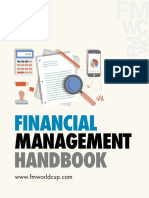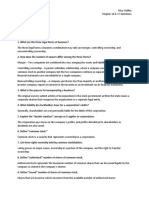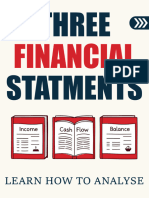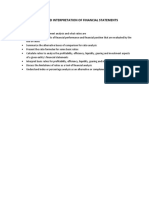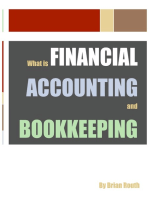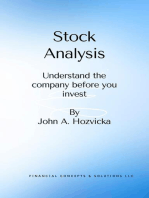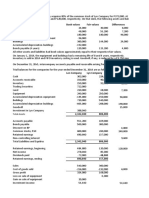Earnings and Cash Flow Analysis: Slides
Earnings and Cash Flow Analysis: Slides
Uploaded by
tahera aqeelCopyright:
Available Formats
Earnings and Cash Flow Analysis: Slides
Earnings and Cash Flow Analysis: Slides
Uploaded by
tahera aqeelOriginal Description:
Original Title
Copyright
Available Formats
Share this document
Did you find this document useful?
Is this content inappropriate?
Copyright:
Available Formats
Earnings and Cash Flow Analysis: Slides
Earnings and Cash Flow Analysis: Slides
Uploaded by
tahera aqeelCopyright:
Available Formats
Earnings and Cash Flow Analysis
Chapter 7
Earnings and Cash Flow Analysis
Slides
7-1
7-2
7-3
7-4
7-5
7-6
7-7
7-8
7-9
7-10
7-11
7-12
7-13
7-14
7-15
7-16
7-17
7-18
7-19
7-20
7-21
7-22
7-23
7-24
7-25
7-26
7-27
7-28
7-29
7-30
7-31
7-32
7-33
7-34
7-35
7-36
Fundamentals of Investments
Cash Flow is a Companys Lifeblood.
Earnings and Cash Flow Analysis
Sources of Financial Information
Sources of Financial Information
Financial Statements
Financial Statements
Work the Web
The Balance Sheet
The Balance Sheet
The Balance Sheet
The Income Statement
The Income Statement
The Cash Flow Statement
The Cash Flow Statement
Performance Ratios and Price Ratios
Performance Ratios and Price Ratios
Performance Ratios and Price Ratios
Work the Web
Financial Statement Forecasting
The Pro Forma Income Statement
The Pro Forma Cash Flow Statement
The Pro Forma Balance Sheet
Projected Profitability and Price Ratios
Projected Profitability and Price Ratios
Work the Web
Adolph Coors Company Case Study
Adolph Coors Company Case Study
Adolph Coors Company Case Study
Adolph Coors Company Case Study
Adolph Coors Company Case Study
Adolph Coors Company Case Study
Adolph Coors Company Case Study
Adolph Coors Company Case Study
Chapter Review
Chapter Review
A-55
A-56
Chapter 7
Chapter Organization
7.1
7.2
7.3
7.4
7.5
Sources of Financial Information
Financial Statements
A. The Balance Sheet
B. The Income Statement
C. The Cash Flow Statement
D. Performance Ratios and Price Ratios
Financial Statement Forecasting
A. The Pro Forma Income Statement
B. The Pro Forma Cash Flow Statement
C. The Pro Forma Balance Sheet
D. Projected Profitability and Price Ratios
Adolph Coors Company Case Study
Summary and Conclusions
Selected Web Sites
http://www.nyse.com
http://www.sec.gov
http://www.thestreet.com
http://www.uoutperform.com
http://www.investorsuniverse.com
Annotated Chapter Outline
7.1
Sources of Financial Information
Edgar: Electronic archive of company filings with the SEC.
10K: Annual company report filed with the SEC.
10Q: Quarterly updates of 10K reports filed with the SEC.
Reliable financial information is a prerequisite to doing good financial analysis.
There are many sources of financial information, including annual reports, The
Wall Street Journal, and SEC information, which includes the Edgar archives.
Edgar includes company 10Ks and 10Qs, as well as other financial data. The
internet also provides a wealth of financial information. The Selected Web Sites,
above, provide a good starting point for finding financial information on the web.
Earnings and Cash Flow Analysis
7.2
A-57
Financial Statements
Balance sheet: Accounting statement that provides a snapshot view of a
company's assets and liabilities on a particular date.
Income statement: Summary statement of a firm's revenues and
expenses over a specific accounting period, usually a quarter or a year.
Cash flow statement: Analysis of a firm's sources and uses of cash over
the accounting period, summarizing operating, investing, and financing
cash flows.
The firm's balance sheet, income statement, and cash flow statement provide
essential, interrelated information necessary for performing a financial analysis.
Remind students that reading and interpreting these financial statements isn't just
"accounting work," it's a requirement of any good financial analyst.
A.
The Balance Sheet
Asset: Anything a company owns that has value.
Liability: A firm's financial obligation.
Equity: An ownership interest in the company.
The Borg balance sheet has four major asset categories: current assets, fixed
assets, investments, and other assets. It has three major liability categories:
current liabilities, long-term liabilities, and other liabilities. Stockholder equity is
the difference between total assets and total liabilities, and includes paid-in
capital and retained earnings. The fundamental accounting identity is:
Assets = Liabilities + Equity
This implies that the left side of the balance sheet always equals the right side.
Financial analysts also find it useful to condense a balance sheet down to its
principle categories.
B.
The Income Statement
Income: The difference between a company's revenues and expenses,
used to either pay dividends to stockholders, or kept as retained earnings
within the company to finance future growth.
The income statement reports revenue and expenses for a corporation over a
one-year (or quarter) period. Subtracting cost of goods sold and operating
expenses from net sales yields operating income. Subtracting investment
A-58
Chapter 7
income, interest expense, and income taxes yields net income, which is also
referred to as "the bottom line." Net income is apportioned to dividends and
retained earnings, in fact:
Net income = Dividends + Retained earnings
C.
The Cash Flow Statement
Cash flow: Income realized in cash form.
Noncash items: Income and expense items not realized in cash form.
Operating cash flow: Cash generated by a firm's normal business
operations.
Investment cash flow: Cash flow resulting from purchases and sales of
fixed assets and investments.
Financing cash flow: Cash flow originating from the issuance or
repurchase of securities and the payment of dividends.
The cash flow statement reports the sources and uses of a firm's cash over a
specified accounting period. The statement begins with net income, and adjusts it
for noncash charges to obtain the operating cash flow. The next two categories
of the statement include investment cash flow and financing cash flow. After
adjusting for these items, the result is the firm's net cash flow during the
accounting period.
D.
Performance Ratios and Price Ratios
Return on assets (ROA): Net income stated as a percentage of total
assets.
Return on equity (ROE): Net income stated as a percentage of
stockholder equity.
The firm's profitability ratios are calculated as follows:
Gross Margin = Gross profit / Sales
Operating Margin = Operating income / Sales
ROA = Net income / Total assets
ROE = Net income / Owners equity
The firm's per-share values are calculated as follows:
Book Value Per Share (BVPS) = Total equity / # shares outstanding
Earnings Per Share (EPS) = Net income / # shares outstanding
Cash Flow Per Share (CFPS) = Operating cash flow / # shares outstanding
Earnings and Cash Flow Analysis
A-59
Notice that the cash flow used above refers to operating cash flow, not the cash
flow from the cash flow statement.
The firm's market value ratios are calculated as follows:
Price / Book (or Market / Book) = Stock price / BVPS
Price / Earnings (P/E) = Stock price / EPS
Price / Cash flow (P/CF) = Stock price / CFPS
7.3
Financial Statement Forecasting
Pro forma financial statements: Statements prepared using certain
assumptions about income, cash flow, and other items. Pro forma literally
means according to prescribed form.
To analyze the impact of possible changes, investments, or changes in sales for
the firm, it is necessary to construct pro forma financial statements for the firm
under various scenarios. This allows the analyst to investigate and analyze the
impact of these actions.
A.
The Pro Forma Income Statement
The pro forma income statement begins with a projection of sales, usually for
more than one scenario. The analyst then works down the income statement,
explaining assumptions that were made in footnotes.
B.
The Pro Forma Cash Flow Statement
The pro forma cash flow statement is prepared using the data from the pro forma
income statement. The resulting net cash flow is applied to adjust the cash
account on the pro forma balance sheet.
C.
The Pro Forma Balance Sheet
The pro forma balance sheet is created by starting with the prior year's balance
sheet, and then making adjustments that are consistent with the pro forma
income statement and cash flow statement.
D.
Projected Profitability and Price Ratios
Using the pro forma statements, the analyst now calculates the relevant ratios to
determine the impact of the projected changes. Using these ratios, the analyst
can compute projected stock prices as described in the last chapter. Three
estimates of the stock price can be obtained from:
BVPS x P/B
EPS x P/E
A-60
Chapter 7
CFPS x P/CF
These numbers may vary greatly. It will then be the analyst's job to determine
which stock prices are the most accurate, and the least sensitive to variance in
the estimates of the inputs.
7.4
Adolph Coors Company Case Study
In this section, the authors provide a complete analysis using the Adolph Coors
Company.
Lecture Tip: To reinforce the information in this chapter, it is helpful to introduce
a project or case that relates to this chapter's material. If grading is not a
consideration, the project could be done individually, with each student selecting
a different firm. To minimize grading, this project could be completed using
teams, with each team doing a different company, or even assigning all teams
the same firm. The advantage of all teams (or students) analyzing the same firm
is that all the computations can be completed beforehand by the instructor, which
is very helpful in answering student questions and checking the results.
One way of formatting this project is to require the students to select a firm and
gather the following material for the firm: annual report, 10K, Standard & Poor's
report, Dunn & Bradstreet report, and ValueLine report. Note that this material
can also be used for projects that relate to other chapters in the text. Using a
spreadsheet, the students will prepare an income statement, balance sheet, cash
flow statement, and ratio analysis for the firm. The instructor will then give
instructions for a change within the firm to allow a pro forma analysis. This could
be as easy as a change in sales of plus or minus ten percent. The students will
use this information to prepare complete pro formas for the firm, calculate ratios,
and then estimate projected stock prices for one-year hence. Since writing is very
important, the students should also prepare a report that includes the following:
describe what they did, provide a complete analysis of the firm, and make
recommendations for the future. Of course, a one-page Executive Summary
would be very beneficial.
7.5
Summary and Conclusions
You might also like
- Financial Management Handbook 1704942604No ratings yetFinancial Management Handbook 170494260445 pages
- SEBI Grade A 2020: Commerce & Accountancy: Cash Flow Statement, Fund Flow Statement, Financial Statement Analysis & Ratio AnalysisNo ratings yetSEBI Grade A 2020: Commerce & Accountancy: Cash Flow Statement, Fund Flow Statement, Financial Statement Analysis & Ratio Analysis20 pages
- Synopsis of Financial Analysis of Indian Overseas BankNo ratings yetSynopsis of Financial Analysis of Indian Overseas Bank8 pages
- Lecture 2728 Prospective Analysis Process of Projecting Income Statement Balance SheetNo ratings yetLecture 2728 Prospective Analysis Process of Projecting Income Statement Balance Sheet36 pages
- Manajemen Investasi Summary Chapter 15 & 16: Dr. Vinola Herawaty, Ak.,MscNo ratings yetManajemen Investasi Summary Chapter 15 & 16: Dr. Vinola Herawaty, Ak.,Msc13 pages
- 05 BSAIS 2 Financial Management Week 10 11No ratings yet05 BSAIS 2 Financial Management Week 10 119 pages
- Financial Analytics - BA Presentation FinalNo ratings yetFinancial Analytics - BA Presentation Final19 pages
- Chapter No. 8: Financial Statements AnalysisNo ratings yetChapter No. 8: Financial Statements Analysis23 pages
- Equity Research Interview Questions 1691470588No ratings yetEquity Research Interview Questions 169147058834 pages
- Short Questions ADC 2nd Semester Adv Fin Accounting 01201No ratings yetShort Questions ADC 2nd Semester Adv Fin Accounting 012017 pages
- Five Steps To Valuing A Business: 1. Collect The Relevant InformationNo ratings yetFive Steps To Valuing A Business: 1. Collect The Relevant Information7 pages
- Financial Management Report (Group2 Delarosa, Peliyo)No ratings yetFinancial Management Report (Group2 Delarosa, Peliyo)6 pages
- CFI Jeff Schmidt - Analysis of Financial StatementsNo ratings yetCFI Jeff Schmidt - Analysis of Financial Statements7 pages
- A Very Simple Guide To Financial StatementsNo ratings yetA Very Simple Guide To Financial Statements22 pages
- Introduction To Financial Ratios: AssetsNo ratings yetIntroduction To Financial Ratios: Assets13 pages
- Analysis and Interpretation of Financial StatementsNo ratings yetAnalysis and Interpretation of Financial Statements25 pages
- Pen Rchive Oulouse Rchive Uverte : O A T A O OataoNo ratings yetPen Rchive Oulouse Rchive Uverte : O A T A O Oatao32 pages
- 8.31 Mercury in Water: S. Nishi B. G. LiptákNo ratings yet8.31 Mercury in Water: S. Nishi B. G. Lipták7 pages
- National Income, Saving and Investment: Handbook of Statistics On Pakistan EconomyNo ratings yetNational Income, Saving and Investment: Handbook of Statistics On Pakistan Economy10 pages
- Processing Polyester Resins For Coatings Applications: Manually Controlled Laboratory EquipmentNo ratings yetProcessing Polyester Resins For Coatings Applications: Manually Controlled Laboratory Equipment11 pages
- Melamine Formaldehyde Curing Studies andNo ratings yetMelamine Formaldehyde Curing Studies and7 pages
- Research Article: Synthesis and Thermal Degradation Studies of Melamine Formaldehyde ResinsNo ratings yetResearch Article: Synthesis and Thermal Degradation Studies of Melamine Formaldehyde Resins7 pages
- United States Patent (,9) : Miyake Et A1No ratings yetUnited States Patent (,9) : Miyake Et A110 pages
- Technical Perspectives: Louise Yamada Technical Research Advisors, LLCNo ratings yetTechnical Perspectives: Louise Yamada Technical Research Advisors, LLC8 pages
- Project Report On Verka by Manisha KaurNo ratings yetProject Report On Verka by Manisha Kaur101 pages
- Course: BSC - Project Management. Unit Name: Resourse Mobilization. Unit Code: Hepm 2401. REG NO - HDE224-2859/2015 Individual AssignmentNo ratings yetCourse: BSC - Project Management. Unit Name: Resourse Mobilization. Unit Code: Hepm 2401. REG NO - HDE224-2859/2015 Individual Assignment11 pages
- BSA 315 Accounting For Business CombinationNo ratings yetBSA 315 Accounting For Business Combination5 pages
- Journal of Economic and Administrative Sciences: Article InformationNo ratings yetJournal of Economic and Administrative Sciences: Article Information22 pages
- Minutes of The Extraordinary Meeting of The Board of DirectorsNo ratings yetMinutes of The Extraordinary Meeting of The Board of Directors9 pages
- PT Pelat Timah Nusantara TBK.: Summary of Financial StatementNo ratings yetPT Pelat Timah Nusantara TBK.: Summary of Financial Statement2 pages
- Rjnth64oq - ACTIVITY - CHAPTER 16 - ACCOUNTING FOR DIVIDENDSNo ratings yetRjnth64oq - ACTIVITY - CHAPTER 16 - ACCOUNTING FOR DIVIDENDS2 pages
- A Merger Refers To The Consolidation of Two ExistingNo ratings yetA Merger Refers To The Consolidation of Two Existing8 pages
- Final 04.05.2021 Proxy Form English VersionNo ratings yetFinal 04.05.2021 Proxy Form English Version2 pages
- ICC - GMP Initiating Coverage Report - Oct 5 2017No ratings yetICC - GMP Initiating Coverage Report - Oct 5 201769 pages
- Equity Full Book Who Didnt Received HardNo ratings yetEquity Full Book Who Didnt Received Hard42 pages
- 7 Steps To Understanding The Stock Market Ebook v3 PDFNo ratings yet7 Steps To Understanding The Stock Market Ebook v3 PDF40 pages
- Ching Wellington vs. Subic Bay Golf and Country Club0% (1)Ching Wellington vs. Subic Bay Golf and Country Club2 pages
- SEBI Grade A 2020: Commerce & Accountancy: Cash Flow Statement, Fund Flow Statement, Financial Statement Analysis & Ratio AnalysisSEBI Grade A 2020: Commerce & Accountancy: Cash Flow Statement, Fund Flow Statement, Financial Statement Analysis & Ratio Analysis
- Synopsis of Financial Analysis of Indian Overseas BankSynopsis of Financial Analysis of Indian Overseas Bank
- Lecture 2728 Prospective Analysis Process of Projecting Income Statement Balance SheetLecture 2728 Prospective Analysis Process of Projecting Income Statement Balance Sheet
- Manajemen Investasi Summary Chapter 15 & 16: Dr. Vinola Herawaty, Ak.,MscManajemen Investasi Summary Chapter 15 & 16: Dr. Vinola Herawaty, Ak.,Msc
- Short Questions ADC 2nd Semester Adv Fin Accounting 01201Short Questions ADC 2nd Semester Adv Fin Accounting 01201
- Five Steps To Valuing A Business: 1. Collect The Relevant InformationFive Steps To Valuing A Business: 1. Collect The Relevant Information
- Financial Management Report (Group2 Delarosa, Peliyo)Financial Management Report (Group2 Delarosa, Peliyo)
- CFI Jeff Schmidt - Analysis of Financial StatementsCFI Jeff Schmidt - Analysis of Financial Statements
- Analysis and Interpretation of Financial StatementsAnalysis and Interpretation of Financial Statements
- What is Financial Accounting and BookkeepingFrom EverandWhat is Financial Accounting and Bookkeeping
- Applied Corporate Finance. What is a Company worth?From EverandApplied Corporate Finance. What is a Company worth?
- Pen Rchive Oulouse Rchive Uverte : O A T A O OataoPen Rchive Oulouse Rchive Uverte : O A T A O Oatao
- National Income, Saving and Investment: Handbook of Statistics On Pakistan EconomyNational Income, Saving and Investment: Handbook of Statistics On Pakistan Economy
- Processing Polyester Resins For Coatings Applications: Manually Controlled Laboratory EquipmentProcessing Polyester Resins For Coatings Applications: Manually Controlled Laboratory Equipment
- Research Article: Synthesis and Thermal Degradation Studies of Melamine Formaldehyde ResinsResearch Article: Synthesis and Thermal Degradation Studies of Melamine Formaldehyde Resins
- Technical Perspectives: Louise Yamada Technical Research Advisors, LLCTechnical Perspectives: Louise Yamada Technical Research Advisors, LLC
- Course: BSC - Project Management. Unit Name: Resourse Mobilization. Unit Code: Hepm 2401. REG NO - HDE224-2859/2015 Individual AssignmentCourse: BSC - Project Management. Unit Name: Resourse Mobilization. Unit Code: Hepm 2401. REG NO - HDE224-2859/2015 Individual Assignment
- Journal of Economic and Administrative Sciences: Article InformationJournal of Economic and Administrative Sciences: Article Information
- Minutes of The Extraordinary Meeting of The Board of DirectorsMinutes of The Extraordinary Meeting of The Board of Directors
- PT Pelat Timah Nusantara TBK.: Summary of Financial StatementPT Pelat Timah Nusantara TBK.: Summary of Financial Statement
- Rjnth64oq - ACTIVITY - CHAPTER 16 - ACCOUNTING FOR DIVIDENDSRjnth64oq - ACTIVITY - CHAPTER 16 - ACCOUNTING FOR DIVIDENDS
- A Merger Refers To The Consolidation of Two ExistingA Merger Refers To The Consolidation of Two Existing
- 7 Steps To Understanding The Stock Market Ebook v3 PDF7 Steps To Understanding The Stock Market Ebook v3 PDF
- Ching Wellington vs. Subic Bay Golf and Country ClubChing Wellington vs. Subic Bay Golf and Country Club


